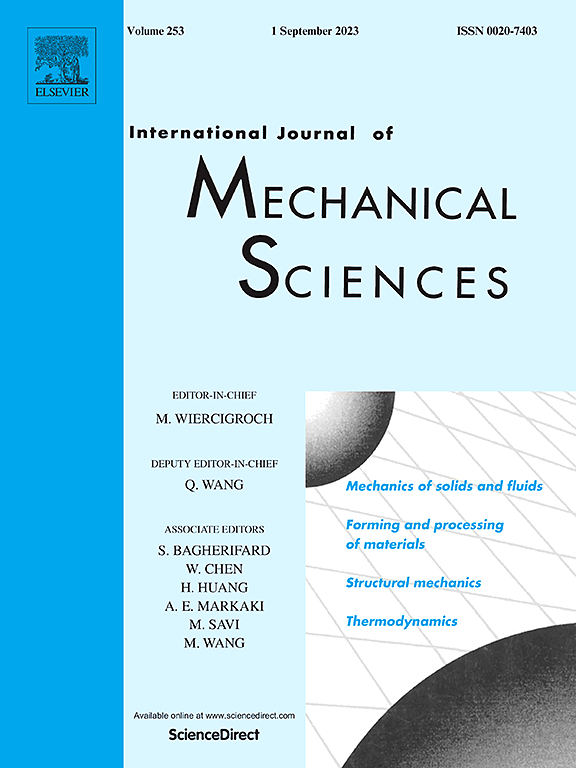Fatigue damage mechanism and life prediction of cold expanded holes
IF 7.1
1区 工程技术
Q1 ENGINEERING, MECHANICAL
International Journal of Mechanical Sciences
Pub Date : 2025-07-19
DOI:10.1016/j.ijmecsci.2025.110622
引用次数: 0
Abstract
Nickel-based superalloy hole structures in aerospace components are prone to premature fatigue failure induced by stress concentration and machining defects, posing significant risks to pressure-bearing critical structures. The cold expansion process (CEP) serves as an effective surface strengthening technique to enhance the fatigue resistance of hole structures. However, the limited understanding of cold expansion strengthening mechanism and the absence of robust fatigue life prediction method constrain the safe operation of the critical components with cold expanded holes. This study presents a multi-stage convex-hull rotary CEP engineered for small hole specimens with diameters varying from 1.0 mm to 3.0 mm. Experiments reveal a threefold improvement in fatigue life when the temperature is below 600 °C and the stress level is less than 800 MPa, providing a strengthening efficacy boundary in terms of the loading conditions for the developed CEP. The microstructure analysis demonstrates that the gradient nanocrystals and compressive residual stress formed on hole root improve fatigue life at lower stress and temperature conditions. Notably, the temperature elevation to 700 °C triggers nanocrystal coarsening and δ-phase stacking fault formation, leading to accelerated fatigue degradation. To predict the fatigue life of expanded hole structures, a data-physics hybrid-driven framework integrating dual-scale modeling with machine learning was developed, achieving both high prediction accuracy and computational efficiency compared with conventional methods. All results were confined within a ±3.0 error band based on the developed method, and the computational speed was improved by approximately four orders of magnitude. This work advances an anti-damage manufacturing technique of hole structures and provides an engineering-oriented life assessment method for surface strengthening components.冷膨胀孔疲劳损伤机理及寿命预测
航空航天零部件中镍基高温合金孔结构容易因应力集中和加工缺陷而发生过早疲劳失效,对承载压力的关键结构构成重大威胁。冷扩工艺是提高孔结构抗疲劳性能的一种有效的表面强化技术。然而,对冷扩强化机理的认识有限,缺乏可靠的疲劳寿命预测方法,制约了冷扩孔关键部件的安全运行。本研究提出了一种多级凸壳旋转CEP,用于直径从1.0 mm到3.0 mm不等的小孔样品。实验结果表明,当温度低于600℃,应力水平小于800 MPa时,CEP的疲劳寿命提高了3倍,为开发的CEP在加载条件下提供了强化效果边界。显微组织分析表明,在较低应力和温度条件下,孔根部形成的梯度纳米晶和压残余应力提高了疲劳寿命。值得注意的是,温度升高到700℃会导致纳米晶粗化和δ相层错的形成,导致疲劳退化加速。为了预测膨胀孔结构的疲劳寿命,开发了一种将双尺度建模与机器学习相结合的数据物理混合驱动框架,与传统方法相比,该框架具有较高的预测精度和计算效率。基于所开发的方法,所有结果都被限制在±3.0的误差范围内,计算速度提高了约4个数量级。提出了一种孔结构的抗损伤制造技术,为表面强化构件的工程化寿命评估提供了一种方法。
本文章由计算机程序翻译,如有差异,请以英文原文为准。
求助全文
约1分钟内获得全文
求助全文
来源期刊

International Journal of Mechanical Sciences
工程技术-工程:机械
CiteScore
12.80
自引率
17.80%
发文量
769
审稿时长
19 days
期刊介绍:
The International Journal of Mechanical Sciences (IJMS) serves as a global platform for the publication and dissemination of original research that contributes to a deeper scientific understanding of the fundamental disciplines within mechanical, civil, and material engineering.
The primary focus of IJMS is to showcase innovative and ground-breaking work that utilizes analytical and computational modeling techniques, such as Finite Element Method (FEM), Boundary Element Method (BEM), and mesh-free methods, among others. These modeling methods are applied to diverse fields including rigid-body mechanics (e.g., dynamics, vibration, stability), structural mechanics, metal forming, advanced materials (e.g., metals, composites, cellular, smart) behavior and applications, impact mechanics, strain localization, and other nonlinear effects (e.g., large deflections, plasticity, fracture).
Additionally, IJMS covers the realms of fluid mechanics (both external and internal flows), tribology, thermodynamics, and materials processing. These subjects collectively form the core of the journal's content.
In summary, IJMS provides a prestigious platform for researchers to present their original contributions, shedding light on analytical and computational modeling methods in various areas of mechanical engineering, as well as exploring the behavior and application of advanced materials, fluid mechanics, thermodynamics, and materials processing.
 求助内容:
求助内容: 应助结果提醒方式:
应助结果提醒方式:


